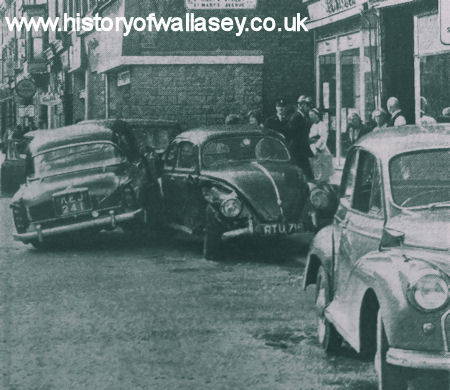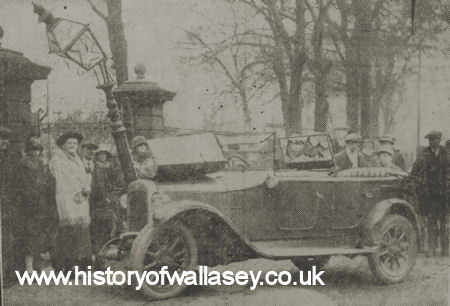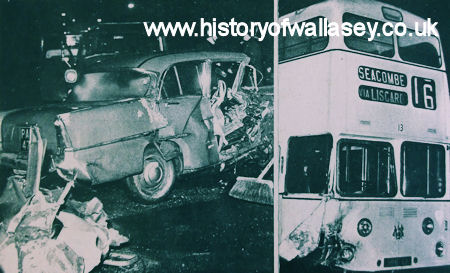In the return of In The Shadow of The Tower we read about a potter, strikers, bus crashes, lifeboat men and take a look at just a few of our fallen who died in the Great War.
The Potter of Wallasey
They called John Goodwin the “Potter of Seacombe”. He was a mild little man who sent the name of the town round the world. Today his plates and stoneware, still bright in blue, purple and cheerful brown, are rare enough to fetch collector’s prices.
It was in 1851 that John Goodwin came to Wallasey from his native Staffordshire. Down by the docks, off Wheatland Lane, he established his business. It was three storeys high and had six kilns.
The first ovens were fired in 1852 and Goodwin looked to a bright future. His was one of the first industries to come to town.
Seacombe was then just a village. It was rustic and leafy, but it had, too, its darker side. It wasn’t all roses, picturesque cottages and scents of flowers and hawthorn. There was awful poverty and hungry children.
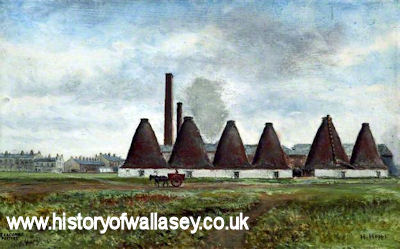 |
A report of the time stated: “One of the great needs of Seacombe is the means of giving regular employment to the large numbers of people who, through want of work, are exposed to so many temptations.”
Goodwin’s pottery brought work. To large numbers of local families it brought a chance to earn a wage and it brought hope.
Goodwin’s place in the story of the town has, I think, been underestimated. He played an important part in its development in the middle years of the 19th Century.
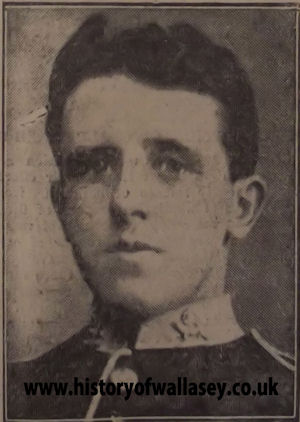
Plucky Seacombe Man Falls In Belgium
The intimation has been received at his home, 155, Wheatland Lane, Seacombe, of the death at Ypres of Private James Kenny, of the Yorkshire and Lancaster Regiment.
A letter from the captain of his company has reached his mother and in this it is mentioned that Private Kenny was buried at St. Jean, not far from the scene of the battle.
Private Kenny, who joined the Army six years ago, returned from India, where he had been stationed some three years, in December, and left for France just after Christmas. He was wounded in February in rather remarkable circumstances. A bullet passed clean through his chest, wounding a comrade who was sitting down to a meal with him. Private Kenny was unconscious that he himself had been hit until it was pointed out to him that he was bleeding. Even then he attached little importance to his injury and, after being bandaged, went back to the trench. Later, however, he had to be invalided home. In his absence his regiment suffered very severely; he wrote to his mother on his return that few of the old faces remained. He did not long survive himself on returning to the firing line.
|
The Garden of Remembrance
The garden was located at All Saints Church, adjacent to Ellery Park Road, and was laid out for Sunday, 11th November, 1947, in remembrance of those who lost their lives during the war. A golden oak was planted by Mrs Philpin in memory of her son John Mervyn, who lost his life on 29th August 1944. Unfortunately the uncertain future of All Saints leads to the garden to be landscaped over.
What’s In A Name?
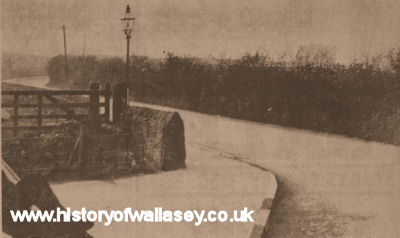 |
Wallasey Road, 1920's |
Old Wallasey took its street names from places and people. It tied them up with its history. The names had meanings.
Seacombe got its first main street in the middle of the 19th Century – Victoria Road (after the Queen, of course). Later it became Borough Road, largely at the request of the local firemen, who were continually getting it confused with the new Brighton Victoria Road.
Poulton Road was originally the road leading to the tree-shaded village of Poulton, close by Wallasey Pool.
Belle Vue Road marks the site of Belle Vue Gardens, which lay between St. Paul’s Church and old Victoria Road, in Seacombe. The gardens, with pavilions and tea tables, were a popular rendezvous for summer visitors in the late 1800s.
Byerley Street was called after Dr. Isaac Byerley, who lived in Myrtle Cottage (on the site of Jubilee Grove). Dr. Byerley was a popular GP in the middle of the 19th Century.
Littledale Road commemorates Mr. Harold Littledale, who lived for many years in the manor house that was the College of Art, in Central Park.
Mainwaring Road gets its name from the Mainwaring family, who owned land in Seacombe.
What fields stood where Wheatland Lane is, and Gorsedale Road recalls the days when it was a rustic walk, bordered by gorse bushes.
Sherlock Lane perpetuates the name of a family resident in Wallasey since early times. An old mill pond once stood close by Mill Lane.
Hose Side Road is a modern adaption of ‘Hoose’, itself a corruption of ‘Hoes’ (sandhills). In the old days Hose Side was a lane bordered by sand dunes.
Seaview Road, as mentioned, was originally Marsden’s Lane who built Liscard Castle (a highly ornate residence nicknamed ‘Marsden Folly’).
The Vyner family, local landowners, gave their name to Vyner Road, and Meddowcroft takes its name from the landowner.
Monk Road and Newell Road were named in honour of Mr. Thomas Monk and his son-in-law, constructors of the Great Float Docks and Seacombe Ferry approaches.
Egremont’s King Street is after Ellen King, who opened the land, and Tobin Street is after local squire Sir John Tobin.
Stringhey Road perpetuates a local field name. Zig Zag Road became so known of its tortuous course, and Holland Road is after the Holland family, who lived in the large house what is now Vale Park.
Griffin Avenue, Moreton, is after Canon Griffin of Sacred Heart Church, one of the great characters of the area in the 1920s and 1930s.
Moreton’s Eleanor and Burden Roads are after Mrs. Eleanor Burden, a pioneer in the 1920’s of caravan sites and for a number of years a member of the Town Council.
Up to 70 – 80 years ago all the names given to roads had local associations. Then the rot set in, and any old names were made to do.
By the mid 20th Century all the names of new housing development had been quite characterless and unimaginative.
It is such a pity. The town’s poorer for it, that much less interesting.
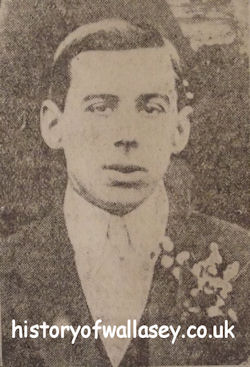
Snipped Through The Head
Mrs. Wright, 30 Lancaster Avenue, Liscard, has received official news that her husband, Private Albert E. Wright, of the King’s Liverpool Regiment has been killed in action. The Company Commander in a letter to the bereaved wife says:-
“I write to express my sympathy with you on the occasion of the death of your husband, Private A.E. Wright, who was killed in action on 31sr July. On this day the battalion attacked the German second system with great success, capturing the whole of its objective with a large number of prisoners, for which it has received high praise. It is small consolation, but it may comfort you somewhat to know that your husband was killed instantly, and did not endure hours of agony like so many. He was sniped through the head. Your husband came nobly forward to fight for a just and righteous cause, against an impious foe, whose career has been stained by every crime. In this he did his duty well and truly, and though he be dead his life cannot be regarded as wasted which given for such a good cause”.
Private Wright was 26 years of age, and leaves a widow and three children. He was formerly employed as a butcher by Mr. R. Abbott, Withens Lane, Liscard. He went to France in January.
|
Seaview Road
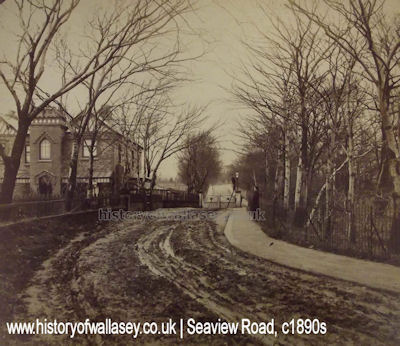 |
View of Seaview Road, looking toward Mount Pleasant Road. |
It is a long, long time ago that Seaview Road looked like this. About 120 years ago, in fact. This was the Seaview Road of the 1890’s when Wallasey was still little more than a collection of villages and Liscard wore a country air about it.
Seaview Road as a built-up thoroughfare is something like one-hundred ten years old. Originally it was simply a cart track up to Hoseside Road, where it was closed by a gate and a lodge house. I have already covered the actual business part in Shopping in Wallasey : Seaview Road.
As can be seen from the photograph, it was rough and muddy and pitted with pools of water. There were hedges and trees on either side, and here and there a large house.
To the top right there is someone doing a spot of repair work to a gas-lamp by the gateway leading to Hoseside. A schoolboy, clad in knickerbockers and a cap, stands watching also on the right.
Up to about thirty years before this photograph Seaview Road had been known as Marsden’s Lane, after a Liverpool brush manufacturer, Mr. John Marsden, He it was who built Liscard Castle. Liscard Castle never was a castle, of course. It was an eccentric sort of building but its battlements and stone lion embellishments gave it a certain stateliness. Some of the locals christened it ‘Brush Castle’. Others called it ‘Marsden Folly’.
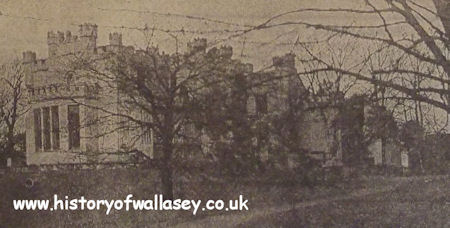 |
The photograph of the ‘castle’ dates back to the late 1890’s. By that time it had become derelict. Remote, painted a dull grey and surrounded by trees, it was reputed to be haunted.
Looking at it, I am not surprised schoolchildren hurried past it and older folk avoided it after dark. It wears a gloomy look. Its narrow driveway leads to crumbling stonework and gaping windows.
In a Seaview Road which was a twisting and uneven cart track, lit only by the spluttering flames of a few-lamps, it must have seemed a good place to leave behind you on winter nights in those far-off Victorian times. In 1902 the town left it behind forever. It was demolished.
One Hundred Years of New Brighton Lifeboat (1860s-1960s)
There had been a station at The Magazines, Wallasey, for many years before the decision in 1863 to station a new boat at New Brighton. The craft ‘Rescue’ came into service on 24th January of that year.
In 1868 the New Brighton station was completely reorganised and the 1863 boat substantially rebuilt. In 1868 a new self-righting lifeboat was added, together with a large wooden boathouse.
With growing commitments, the old Mersey Docks and Harbour Board found it impossible to give proper care to the lifeboat service and in July, 1894, the whole organisation was transferred to the Royal National Lifeboat Institution.
At the beginning of the century, when all lifeboat stations, were hard-pressed for money, there were appeals known as the Lifeboat Saturday Fund, and regattas and rowing races were held on the Mersey.
There was great rivalry, not always of a friendly nature, between the crews of the lifeboat stations – Liverpool, Formby, Point of Ayre and Hoylake.
The lifeboat ‘Willie and Arthur’ took part in September, 1875, in a rescue. The boat was called to the wrecked ‘United States’ barque Ellen Southard and its action was so gallant that the US Government under a special Act of Congress conferred gold medals on all members of the New Brighton crew.
In November, 1928, came the famous rescue of members of the crew of the French merchantman ‘Emile Delmas’. The call came early on the morning of 24th November. The 1,300 ton vessel was being driven on the Horse Bank, off Southport, in a 100 mph gale.
The local lifeboat fought an eight hour battle with massive seas. Only one life was lost – a Frenchman misjudged the jumping distance to the lifeboat’s net.
Between the 1860s - 1960s there have been 15 boats that have been used at New Brighton. All but two were outright gifts or purchased with legacies left the purpose.
Famous among them were The Queen, William and Kate Johnson (1924-1950) and Edmund and Mary Robinson (1938-1950). These three boats alone between them saved 524 lives. They attended scores of vessels in distress.
Two boats were continuously on call here from 1863 to 1950, when the establishment reduced to one. ‘Norman B. Corlett’ was presented to the station at the cost of £31,000 by Mr. W.E. Corlett and family in memory of a son who was lost in local waters. The Duchess of Kent (Princess Marina) named the boat at Liverpool in 1951.
The men who manned her – and those who continue on today – are all volunteers and are the inheritors of a great tradition. It is something that gives them enormous pride.
Many storms have raged and many calls have been answered since the old-time lifeboatmen actually rowed their craft, but the spirit of service remains the same.
Over those one hundred years covered here the station has saved more than 900 lives. ‘Rescue’ was the first boat. ‘Rescue’ has been the station’s watchword.
Wallasey On Strike
“Stones were thrown, some windows were smashed, but there were few serious incidents here...” That was the news reporting in the local press on Wallasey and the General Strike of May 1926. The big stoppage was born at midnight on 3rd May and lasted until 12th May.
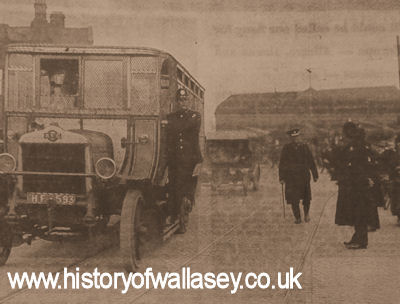 |
The photo above was taken at Seacombe Ferry. It shows cars and crowds at the old ferry entrance (it would be another five or six years before it got the appearance it has today). The other is of a single-decker motor bus with its windows encased in wire mesh. A burly constable stands on the running board.
Those cars of the period! Those fashions! Every man wears a trilby, a bowler or a cap. For collars and wraps are popular with the ladies.
During the General Strike trams and buses in Wallasey were suspended for a day-and-a-half. “Motor owners are expected to fill every vacant seat in their cars while travelling to and from work,” read posters.
The old Seacombe Presbyterian Church was taken over by the Police for enrolling special constables. Officers were on duty round the Town Hall in Brighton Street.
The then Mayor (Alderman J.W. Holdsworth) issued a statement “I desire to deny certain rumours that I have been seriously injured on the occasion of an attempt to turn out the Corporation motor buses.”
There were, it seems, lots of rumours flying around the town. In actual fact, the local scene was decidedly quiet.
The opening of New Brighton’s holiday season (it had been planned to invite civic leaders from all parts of the North) was abandoned,” in view of the national crisis.”
As acting secretary of the Trades Union Council, Lord Citrine, a young electrician from Wallasey, had his letters passed between the TUC and the Prime Minister.
Bicycles were the town’s main means of transport. At Seacombe Ferry they were stacked five and six deep. Some were even piled one on top of the other.
Coal was rationed and bread was in short supply. There were notices everywhere, with anxious crowds gathered about them.
And little groups of men standing at street corners, sad in shabby suits, and silent, with stubs of cigarettes in their mouths.
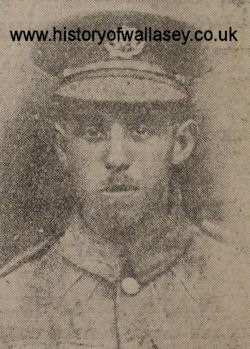
New Brighton Soldier Killed
The sad intelligence has been received that Private William Henry Humphreys, of the Cheshire Regiment, was killed in action on June 29. The brave young soldier, who only 19 years of age, joined the colours in May 1916, and had been five months in France. He was educated at Vaughan Road School, where he was awarded the high-class certificate for education generally. He was formerly employed with Messrs. Read, Ltd., engineers, Bridgewater Street Liverpool and attended St. James’ Church. He also took a keen interest in all kinds of sport – football being his favourite hobby. He was the eldest son and Mr. and Mrs. William Humphreys, 25 Victoria Road, New Brighton.
2nd Lieutenant J.W. Wynne, commanding officer of the platoon, writes:-
“Dear Mrs Humphreys – It is with my deepest sympathy that I have to convey to you the sad news of the death of your son, which occurred on the 29th June. I was very near him when he was killed by a shell exploding in the trench. You will, perhaps, find some little consolation in the fact that he suffered no pain, as death was instantaneous. Allow mw to convey to you the heartfelt sympathy of the whole of his comrades in your very sad loss”.
|
A Pavilion Full Of Pierrots
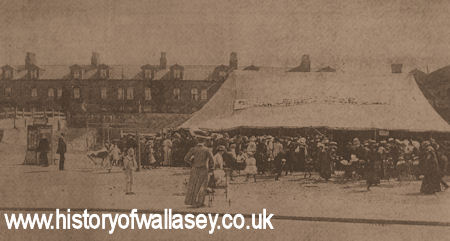 |
It is getting on for something like 120 years of the picture being taken from the New Brighton seafront. On a bright summer afternoon shortly after the turn of the last century the crowds were paying threepence and sixpence to enter the large tent which housed a pierrot show.
Inside the tent, pitched on a spot now occupied by the New Palace, there was a wooden stage and tinkling piano. The performers wore pom-poms, ruffles and frills, They sang the hit songs of the Edwardian music hall.
Close by, to the left, was the Ham and Egg Parade. It stretched along the sea front from the corner of Victoria Road. It was to be demolished in 1907.
The pierrot tent picture weathered the years remarkably well. The original is as clear as one could wish, and underneath the magnifier reveals a wealth of detail.
Virginia Road is in the background. It was to be a good many years before the former bus terminus and buildings obscured its fine view of the Mersey.
There’s a penny postcard stand on the left, with a be-capped salesman standing beside it. A notice on the stand carried the information that he is available to take the photographs of visitors.
There is a real atmosphere of summer about the picture. The ladies wear large floppy hats and fussy bonnets. Lots of the men sport jolly straw boaters.
There are babies in large-wheeled prams. There are boys and girls in holiday dress. They look lively and cheerful and all-out for fun.
The pierrots – George Somebody-or-Other’s – must have been pretty good, for the queue to get into the tent is a long one, stretching to the right.
Almost in the centre of the crowd are a nattily dressed young man and a white-bloused young lady. Sweethearts I wonder? Or a couple about to start a holiday romance?
The nice thing about old pictures, snapshots from the pasts, is that one can with impunity and pleasure invent one’s own stories about the people in them.
The little boy in the left foreground looks a bit ill at ease in his white pants and satin blouse. He would probably dearly love to shed his finery and get down to digging in the nearby sands.
The lady with her back to the camera is pushing a sleeping baby. Her parasol hangs from the handle of the pram. She is dressed in a smart two-piece affair with the top half cut on slightly military lines. Her hat is decorated with a large ostrich plume.
They look nice people, happy people. The Wallasey to which they belonged was quiet and slow- moving.
It hadn’t yet seen a motor bus. It hadn’t yet got a massive promenade. Its summer pierrots hadn’t yet heard of ‘pop’, ‘rap’ or microphones. Lucky Wallasey! Lucky people!
Ivy Wallasey
There would seem to have been no shortage of ivy Wallasey of years ago. The stuff was everywhere. You see it in most of the old photographs, clinging to buildings and decorating walls and hedgerows.
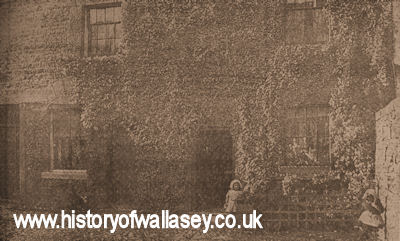 |
The picture above shows the ivy covered little houses which were a picturesque feature of the Liscard Village end of Urmson Road. Two little girls stand outside them in the sunlight.
It is hard to believe Liscard as a semi-rural area, but that is what was some 110 years ago. It had shops in plenty, but it had, too, little cottages with big gardens, smithies, and fields. There really was a mill pond in Mill Lane. An interesting A – Z of Buildings which lists many of the cottages are found on the History of Wallasey website.
Old photographs show the area to have richly provided with trees – Seaview Road was a great long avenue of oaks and elms. There were quaint stiles and a sea of thatched roofs.
A curious old building was the Blue Bell Inn. The roof, covered with turf, had a luxuriant crop of grass growing all over it. The little place disappeared at the turn of the last century. The site would be become the old Fire Station and today is a car park.
Trafford House stood where the Post Office is today. It was demolished just before World War One.
Urmson’s House stood opposite the old Fire Station in Liscard Village. It dated back to 1729. It lived on until 1928.
Fields and cottages and trees – that was the Liscard our (great) grandparents knew. A place of open spaces and quiet corners. And lots of ivy.
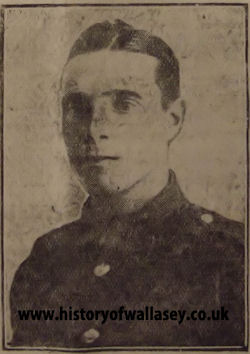
The Bravest of the Brave
Two months ago Lance Corporal John William Langley, of the King’s Liverpool Regiment, the eldest son of Mr. J. Langley, coal merchant, of 4 Cromer Drive. Liscard, “won the Military Medal for gallantry on the field. He was shortly expected home, but the sad news has been received by his parents that he was shot by a sniper whilst on dangerous work, for which he volunteered. Before the war Lance-Corporal Langley was apprenticed to Mr. Bellis, plumber, of Liscard. He was a member of the 12th Wallasey Scouts, and was an old St. Mary’s boy, being captain of the football team, while he afterwards played for Christ Church and won many football medals. The officer in charge of the company writes to the parents:- “I was ordered to take out a patrol at 2.30 in the afternoon (August 14) to locate the Boches, so I asked for volunteers. Your son asked me to let him come along, which I did, so with your son and two others I proceeded out. The Boches were over one and three-quarter miles away, so we all strolled along joking and looking for pieces of Boches equipment, etc. At about 4 pm we got to the Boches position without being seen, but as soon as we got in their trench they started coming along in large numbers so we decided to withdraw. I told your son to crawl along the side of the road and get back towards our line whilst I would cover his withdrawal. As soon as I started crawling a concealed sniper shot your son through the side in line with his heart. I might say that the others of the patrol were wounded. Your brave was the bravest of the brave. Four times previously he volunteered to come out on night patrol with me. He was the best NCO in my patrol, and I had just previously recommended him for promotion. He was beloved by all the men in his section, and was most popular with all who knew him. I miss him tremendously. He was my right-hand man. It must be a most extremely heavy blow to you all, but I am sure you will find a little consolation in the knowledge of his great bravery and the gloriously brave manner in which he met his death. In conclusion, I implore you to accept my sincere sympathy and also the sympathy of all his pals”.
|
Liscard Road Accidents
The photograph above shows the scene of a car crash on Liscard Road opposite Victoria Central Hospital (where the ambulance station is today).
It was 5.40 pm on 15th June, 1965 when a car travelling towards Liscard ploughed into three cars parked on its offside, causing the third vehicle to collide with another car.
The driver of the first car was Jason Douglas Scott, aged 19, who lived in Langdale Road. He was treated at the Victoria Central Hospital for shock whilst his passenger, Janice Pickering, aged 16, of Seabank Road, received treatment for a knee injury.
In the photograph you can see Scott's car is embedded into two parked cars which had been forced onto the pavement by the impact.
The photograph taken in February, 1925, shows an accident again on Liscard Road. This time a New Brighton lady collides with a lamp post outside the entrance to Central Park. No one was hurt.
Another accident in Liscard Road sees a Vauxhall car completely wrecked after a late night crash with the No. 16 Wallasey Corporation bus in February 1968. The driver, William Morgan, of New Brighton, was taken to VCH with chest injuries. No one was hurt on the bus.











